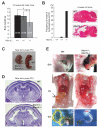ATXN1 protein family and CIC regulate extracellular matrix remodeling and lung alveolarization
- PMID: 22014525
- PMCID: PMC3253850
- DOI: 10.1016/j.devcel.2011.08.017
ATXN1 protein family and CIC regulate extracellular matrix remodeling and lung alveolarization
Abstract
Although expansion of CAG repeats in ATAXIN1 (ATXN1) causes Spinocerebellar ataxia type 1, the functions of ATXN1 and ATAXIN1-Like (ATXN1L) remain poorly understood. To investigate the function of these proteins, we generated and characterized Atxn1L(-/-) and Atxn1(-/-); Atxn1L(-/-) mice. Atxn1L(-/-) mice have hydrocephalus, omphalocele, and lung alveolarization defects. These phenotypes are more penetrant and severe in Atxn1(-/-); Atxn1L(-/-) mice, suggesting that ATXN1 and ATXN1L are functionally redundant. Upon pursuing the molecular mechanism, we discovered that several Matrix metalloproteinase (Mmp) genes are overexpressed and that the transcriptional repressor Capicua (CIC) is destabilized in Atxn1L(-/-) lungs. Consistent with this, Cic deficiency causes lung alveolarization defect. Loss of either ATXN1L or CIC derepresses Etv4, an activator for Mmp genes, thereby mediating MMP9 overexpression. These findings demonstrate a critical role of ATXN1/ATXN1L-CIC complexes in extracellular matrix (ECM) remodeling during development and their potential roles in pathogenesis of disorders affecting ECM remodeling.
Copyright © 2011 Elsevier Inc. All rights reserved.
Figures





Similar articles
-
Partial loss of ataxin-1 function contributes to transcriptional dysregulation in spinocerebellar ataxia type 1 pathogenesis.PLoS Genet. 2010 Jul 8;6(7):e1001021. doi: 10.1371/journal.pgen.1001021. PLoS Genet. 2010. PMID: 20628574 Free PMC article.
-
Novel ATXN1/ATXN1L::NUTM2A fusions identified in aggressive infant sarcomas with gene expression and methylation patterns similar to CIC-rearranged sarcoma.Acta Neuropathol Commun. 2022 Jul 14;10(1):102. doi: 10.1186/s40478-022-01401-z. Acta Neuropathol Commun. 2022. PMID: 35836290 Free PMC article.
-
Structural basis of protein complex formation and reconfiguration by polyglutamine disease protein Ataxin-1 and Capicua.Genes Dev. 2013 Mar 15;27(6):590-5. doi: 10.1101/gad.212068.112. Genes Dev. 2013. PMID: 23512657 Free PMC article.
-
Functional implications of paralog genes in polyglutamine spinocerebellar ataxias.Hum Genet. 2023 Dec;142(12):1651-1676. doi: 10.1007/s00439-023-02607-4. Epub 2023 Oct 16. Hum Genet. 2023. PMID: 37845370 Free PMC article. Review.
-
Beyond the glutamine expansion: influence of posttranslational modifications of ataxin-1 in the pathogenesis of spinocerebellar ataxia type 1.Mol Neurobiol. 2014 Dec;50(3):866-874. doi: 10.1007/s12035-014-8703-z. Epub 2014 Apr 22. Mol Neurobiol. 2014. PMID: 24752589 Free PMC article. Review.
Cited by
-
Ataxin1L is a regulator of HSC function highlighting the utility of cross-tissue comparisons for gene discovery.PLoS Genet. 2013 Mar;9(3):e1003359. doi: 10.1371/journal.pgen.1003359. Epub 2013 Mar 28. PLoS Genet. 2013. PMID: 23555280 Free PMC article.
-
Cliques for the identification of gene signatures for colorectal cancer across population.BMC Syst Biol. 2012;6 Suppl 3(Suppl 3):S17. doi: 10.1186/1752-0509-6-S3-S17. Epub 2012 Dec 17. BMC Syst Biol. 2012. PMID: 23282040 Free PMC article.
-
Intranuclear inclusions of polyQ-expanded ATXN1 sequester RNA molecules.Front Mol Neurosci. 2023 Dec 6;16:1280546. doi: 10.3389/fnmol.2023.1280546. eCollection 2023. Front Mol Neurosci. 2023. PMID: 38125008 Free PMC article.
-
Antenatal exposure of maternal secondhand smoke (SHS) increases fetal lung expression of RAGE and induces RAGE-mediated pulmonary inflammation.Respir Res. 2014 Oct 23;15(1):129. doi: 10.1186/s12931-014-0129-7. Respir Res. 2014. PMID: 25338658 Free PMC article.
-
Capicua regulates proliferation and survival of RB-deficient cells in Drosophila.Biol Open. 2013 Feb 15;2(2):183-90. doi: 10.1242/bio.20123277. Epub 2012 Nov 23. Biol Open. 2013. PMID: 23429853 Free PMC article.
References
-
- Antoniou SA, Antoniou GA, Granderath FA, Simopoulos C. The role of matrix metalloproteinases in the pathogenesis of abdominal wall hernias. Eur. J. Clin. Invest. 2009;39:953–959. - PubMed
-
- Banfi S, Servadio A, Chung MY, Kwiatkowski TJ, McCall AE, Duvick LA, Shen Y, Roth EJ, Orr HT, Zoghbi HY. Identification and characterization of the gene causing type 1 spinocerebellar ataxia. Nat. Genet. 1994;7:513–520. - PubMed
-
- Bettegowda C, Agrawal N, Jiao Y, Sausen M, Wood LD, Hruban RH, Rodriguez FJ, Cahill DP, McLendon R, Riggins G, et al. [Accessed August 10, 2011];Mutations in CIC and FUBP1 Contribute to Human Oligodendroglioma. Science. 2011 Available at: http://www.ncbi.nlm.nih.gov/pubmed/21817013. - PMC - PubMed
-
- Bowman AB, Lam YC, Jafar-Nejad P, Chen H-K, Richman R, Samaco RC, Fryer JD, Kahle JJ, Orr HT, Zoghbi HY. Duplication of Atxn1l suppresses SCA1 neuropathology by decreasing incorporation of polyglutamine-expanded ataxin-1 into native complexes. Nat. Genet. 2007;39:373–379. - PubMed
Publication types
MeSH terms
Substances
Associated data
- Actions
Grants and funding
LinkOut - more resources
Full Text Sources
Molecular Biology Databases
Miscellaneous

